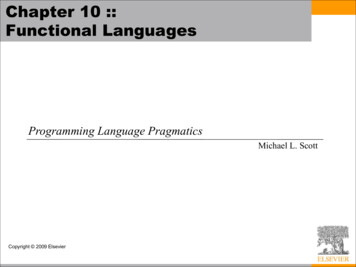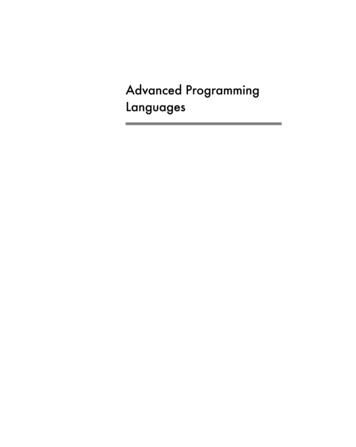
Transcription
Chapter 10 ::Functional LanguagesProgramming Language PragmaticsMichael L. ScottCopyright 2009 Elsevier
Historical Origins The imperative and functional models grew outof work undertaken Alan Turing, AlonzoChurch, Stephen Kleene, Emil Post, etc. 1930s– different formalizations of the notion of an algorithm,or effective procedure, based on automata, symbolicmanipulation, recursive function definitions, andcombinatorics These results led Church to conjecture that anyintuitively appealing model of computing wouldbe equally powerful as well– this conjecture is known as Church’s thesisCopyright 2009 Elsevier
Historical Origins Mathematicians established a distinctionbetween– constructive proof (one that shows how to obtain amathematical object with some desired property)– nonconstructive proof (one that merely shows thatsuch an object must exist, e.g., by contradiction)Copyright 2009 Elsevier
Historical Origins Turing’s model of computing was the Turingmachine a sort of pushdown automaton usingan unbounded storage “tape”– the Turing machine computes in an imperativeway, by changing the values in cells of its tape –like variables just as a high level imperativeprogram computes by changing the values ofvariablesCopyright 2009 Elsevier
Historical Origins Church’s model of computing is called thelambda calculus– based on the notion of parameterized expressions(with each parameter introduced by an occurrenceof the letter λ—hence the notation’s name.– Lambda calculus was the inspiration for functionalprogramming– one uses it to compute by substituting parametersinto expressions, just as one computes in a highlevel functional program by passing arguments tofunctionsCopyright 2009 Elsevier
Functional Programming Concepts Functional languages such as Lisp, Scheme,FP, ML, Miranda, and Haskell are anattempt to realize Church's lambda calculusin practical form as a programming languageCopyright 2009 Elsevier
Functional Programming Concepts Key Idea: Define the outputs of a program asa mathematical function of the inputs– No mutable state– No side-effects– Emphasizes recursion rather than iterationCopyright 2009 Elsevier
Origins of Functional Languages AI modules for game playing in the 1950s Branch-and-bound algorithms ideally suited forrecursion
Functional Programming Concepts Significant features, many of which aremissing in some imperative languages––––––1st class and high-order functionsimplicit, parametric polymorphismpowerful list facilitiesstructured function returnsfully general aggregatesgarbage collectionCopyright 2009 Elsevier
Functional Programming Concepts So how do you get anything done in a functionallanguage?– Recursion (especially tail recursion) takes the place ofiteration– In general, you can get the effect of a series ofassignmentsx : 0.x : expr1.x : expr2.from f3(f2(f1(0))), where each f expects thevalue of x as an argument, f1 returns expr1, and f2returns expr2Copyright 2009 Elsevier
Functional Programming Concepts Recursion even does a nifty job of replacingloopingx : 0; i : 1; j : 100;while i j dox : x i*j; i : i 1;j : j - 1end whilereturn xbecomes f(0,1,100), wheref(x,i,j) if i j thenf (x i*j, i 1, j-1) else xCopyright 2009 Elsevier
Natural Recursive Problems Recurrences– E.g., factorial:0! 11! 1n! n * (n-1)!– E.g., greatest common divisorint gcd(int a, int b) {if (a b) return a;else if (a b) return gcd(a - b, b);else return gcd(a, b - a);} Tree traversals Graph traversals
Speeding Up Recursion Tail recursion: Recursion in which additionalcomputation never follows a recursive call Compiler optimizes a tail recursive function by reusing the stack frame for the function Exampleint gcd(int a, int b) {start: if (a b) return a;else if (a b) { a a - b; goto start; }else { b b - a; goto start; }}
Transforming Recursion to Use TailRecursion continuations: arguments that contain intermediateresults which get passed to successive recursivecalls Examplefactorial(n, product) {if (n 0 or n 1) return productelsereturn factorial(n-1, product * n) }
Continuations are like imperativeprogramming Example: The fibonacci recurrence relationfib0 0fib1 1fibn fibn-1 fibn-2 a natural functional implementation:fib(n) {if (n 0) return 0else if (n 1) return 1else return fib(n-1) fib(n-2)}
Continuations (cont) An efficient C implementationint fib(int n) {int f1 0; f2 1;int i;for (i 2; i n; i ) {int temp f1 f2;f1 f2;f2 temp;}return f2;}
Continuations (cont) A functional implementation of fib usingcontinuationsfib(n) {fib-helper(f1, f2, i) {if (i n) return f2;else return fib-helper(f2, f1 f2, i 1);}return fib-helper(0, 1, 0);}
Functional Programming Concepts Lisp also has (these are not necessarypresent in other functional languages)– homo-iconicity: A Lisp program can bemanipulated as data. This property is often summarized by saying thatthe language treats "code as data". Lisp stores data using list and code is also writtenusing lists– self-definition– read-evaluate-printCopyright 2009 Elsevier
Functional Programming Concepts Variants of LISP––––––Pure (original) LispInterlispMacLispEmacs LispCommon LispSchemeCopyright 2009 Elsevier
Functional Programming Concepts Pure Lisp is purely functional; all other Lispshave imperative features All early Lisps dynamically scoped– Not clear whether this was deliberate or if it happenedby accident Scheme and Common Lisp statically scoped– Common Lisp provides dynamic scope as an optionfor explicitly-declared special functions– Common Lisp now THE standard Lisp Very big; complicated (The Ada of functionalprogramming)Copyright 2009 Elsevier
Functional Programming Concepts Scheme is a particularly elegant Lisp Other functional languages––––MLMirandaHaskellFP Haskell is the leading language for researchin functional programmingCopyright 2009 Elsevier
A Review/Overview of Scheme Scheme is a particularly elegant Lisp– Interpreter runs a read-eval-print loop– Things typed into the interpreter are evaluated(recursively) once– Anything in parentheses is a function call(unless quoted)– Parentheses are NOT just grouping, as they arein Algol-family languages Adding a level of parentheses changes meaningCopyright 2009 Elsevier
A Review/Overview of SchemeExample program - Simulation of DFA We'll invoke the program by calling a function called'simulate', passing it a DFA description and an inputstring– The automaton description is a list of three items: start state the transition function the set of final states– The transition function is a list of pairs the first element of each pair is a pair, whose first element is a stateand whose second element in an input symbol if the current state and next input symbol match thefirst element of a pair, then the finite automaton entersthe state given by the second element of the pairCopyright 2009 Elsevier
A Review/Overview of SchemeExample program - Simulation of DFACopyright 2009 Elsevier
A Review/Overview of SchemeExample program - Simulation of DFACopyright 2009 Elsevier
Evaluation Order Revisited Applicative order– what you're used to in imperative languages– usually faster Normal order– like call-by-name: don't evaluate arg until youneed it– sometimes faster– terminates if anything will (Church-Rossertheorem)Copyright 2009 Elsevier
Evaluation Order Revisited In Scheme– functions use applicative order defined withlambda– special forms (aka macros) use normal orderdefined with syntax-rules A strict language requires all arguments to bewell-defined, so applicative order can be used A non-strict language does not require allarguments to be well-defined; it requiresnormal-order evaluationCopyright 2009 Elsevier
Evaluation Order Revisited Lazy evaluation gives the best of bothworlds But not good in the presence of side effects.– delay and force in Scheme– delay creates a "promise"Copyright 2009 Elsevier
High-Order Functions Higher-order functions– Take a function as argument, or return a functionas a result– Great for building things– Currying (after Haskell Curry, the same guyHaskell is named after) For details see Lambda calculus on CD ML, Miranda, and Haskell have especially nice syntaxfor curried functionsCopyright 2009 Elsevier
Functional Programming in Perspective Advantages of functional languages– lack of side effects makes programs easier tounderstand– lack of explicit evaluation order (in somelanguages) offers possibility of parallel evaluation(e.g. MultiLisp)– lack of side effects and explicit evaluation ordersimplifies some things for a compiler (providedyou don't blow it in other ways)– programs are often surprisingly short– language can be extremely small and yet powerfulCopyright 2009 Elsevier
Functional Programming in Perspective Problems– difficult (but not impossible!) to implementefficiently on von Neumann machines lots of copying of data through parameters (apparent) need to create a whole new array in order tochange one element heavy use of pointers (space/time and locality problem) frequent procedure calls heavy space use for recursion requires garbage collection requires a different mode of thinking by the programmer difficult to integrate I/O into purely functional modelCopyright 2009 Elsevier
Functional Programming Concepts Scheme is a particularly elegant Lisp Other functional languages -ML -Miranda -Haskell -FP Haskell is the leading language for research in functional programming










